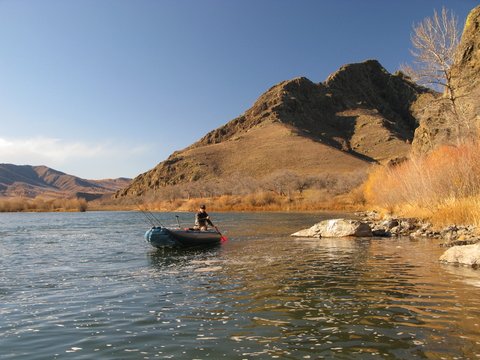Fishing for trout is a blast no matter what technique you try. And while trout fishing from the shore can be exciting, there’s nothing like hooking them while trolling in a 12-14 foot boat.
Although there’s a lot of different setups for trolling (and a lot of opinions on which way is best), there is one that almost always works for me.
Nearly every successful trout fisherman has a little fishing boat. Many of them (including mine) look like they were bought in 1961 and fell off the trailer a few times throughout the years. But the reality is that trolling for trout (and most fish) increases your odds of success.
Being able to move anywhere and cover a lot of area while trolling is a no-brainer when it comes to increasing your odds of finding the fish. You can also experiment with different depths and a variety of trolling setups—you got a lot more options than when you’re on the shore.
But, choosing a good setup can be overwhelming unless you know what works for the lake you’re fishing. The best thing you can do is try to get a little inside info from the guy at the bait shop or other fishermen. There’s always a trick and most folks will give you some tips.
If your tackle box looks anything like mine, you’ll find lures you haven’t seen in years and some you’ve never even tried. But no matter what, I almost always use flashers or dodgers. In my 40 plus years of trolling, it’s a tried and true method for me. The trick is figuring out what to trail behind them. If you’re not sure what the hot lure is, start throwing everything out there.
Although I don’t use dodgers as much as flashers, the darting action of the dodger can be effective if you’re trailing the right spinner, spoon, Flatfish, Rapala etc. That’s where you get to experiment. You can always use a three-way swivel in front of the dodger and add some weight to get the setup deeper. Lead core line is great for going deep. I always have a setup on board.
And while I could write a book on trolling for trout and all the different setups, depths, techniques and so on, there’s one technique I can always fall back on when I get stumped. The old flasher and worm setup has probably caught more fish than all the lures ever invented— combined! No matter if I’m on a big lake such as Tahoe or a small lake in the foothills, if the fish are biting and I find them, I usually hook up using this method.
A decent set of small chrome flashers ( 2 1/2 to 3 1/2 inches long with a rudder), three feet of leader (2 to 4 pound test) and a “number 8” hook will do the trick in most scenarios. You can use a worm threader or simply thread the hook through the meaty part of the worm and let it hang naturally without wading it up.
An old timer once told me that when you think you’ve let out enough line, let out twice that much, and when you think you’re trolling slow enough, go half that fast. Wise words indeed and I’ve always adhered to his advise. All you want to do is go fast enough to make the flashers spin—you’ll see the action on your rod tip. If you get hung up, let out less line next time. I always fall back on this method when I’m not getting on the fish and I’m usually happy I did.
© Peter Zachar | Dreamstime.com – Boat fishing on river








